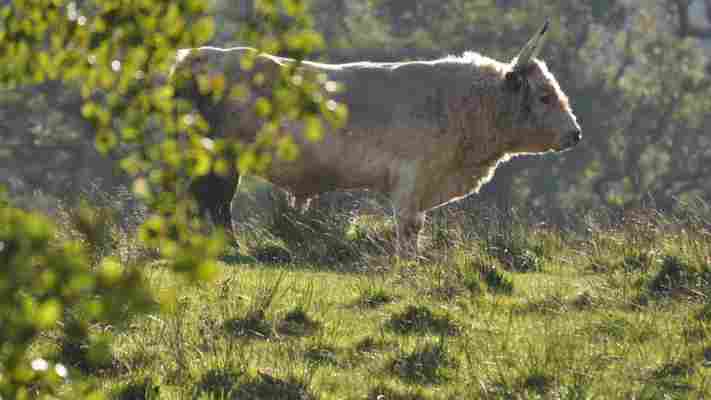A British beast rarer than the panda
"The good news is, if they charge us, you don't have to outrun them. You just have to outrun the person next to you," said Denene Crossley, one of the two sisters who serve as wardens of these strange and rare beasts.

Ill-tempered, unpredictable and capable of a not-exactly-leisurely top speed of 30mph, Chillingham wild cattle are not to be trifled with. Crossley and I were observing the animals from a safe distance, amid the sloping meadows and ancient oak and alder forests of Chillingham Cattle Park in Northumberland, where they have roamed free from human interference for the better part of 1,000 years.
White as snow, with sinewy frames, a fierce temperament and vast horns that curve menacingly into jet-black tips, these are no ordinary oxen. Among the last remaining wild cattle in the world, they retain a primeval character. They are also some of the rarest animals on the planet; currently numbering around 130, they are far fewer in number than giant pandas, Siberian tigers or mountain gorillas.
"Although there are about 1.2 billion cattle in the world, only very few – on a few oceanic islands, and at Chillingham – live free of human interference or management," explained Stephen Hall, professor of animal science at the University of Lincoln and a trustee of the Chillingham Wild Cattle Association. "They are the only British breed of cattle to have escaped 'improvement' by selective breeding during the so-called Agricultural Revolution of approximately 200 to 300 years ago."
In general body size and shape they are, effectively, medieval cattle
This is evident in their small stature – the bulls weigh in at around 400kg, less than one-third that of modern continental breeds – and in the cows' small udders, which only have to produce milk for one calf at a time. "In general body size and shape they are, effectively, medieval cattle," said Hall.

Chillingham Castle is said to be the most haunted castle in Britain (Credit: Chillingham Castle)
It was the medieval fervour for blood sports that meant the Chillingham cattle were originally enclosed in the park around 800 years ago – and left to live in a wild state. "They were treated like a large game animal," explained Crossley. "The residents of Chillingham Castle would have come across on horseback with packs of hounds and lances, and they would have chased them through the park. That's why they were kept wild in the first place – they wanted that fight-or-flight response."
The cattle's spectral form fits in perfectly against the backdrop of the castle, located next to the cattle park but now under separate ownership and said to be the most haunted castle in Britain. Dave Godfrey, a tour guide in one of the castle's opulent state rooms, spoke of disembodied voices that babble incoherently in the chapel, ghouls flitting across moonlit courtyards and a frail figure who approaches guests in the pantry, begging them for water.
"Then there's the Blue Boy, who heard some wrongdoings being plotted and was encased in a wall while he was still alive," said Godfrey.
You may also be interested in: • England's crop circle controversy • The UK's forgotten 'fifth nation' • England's rare meat-eating plants
Reports of a ghostly boy seen in the castle's Pink Room were just another part of the estate's folkloric fabric, until workmen in the 1920s made an unexpected discovery while excavating a wall. "They found the remains of a boy, with the bones on his fingers worn down. They gave him a Christian burial, and his ghost hasn't been seen since." My girlfriend and I couldn't resist the opportunity to spend the night in the castle's old guard room, although we didn't experience anything spooky. Nor has Godfrey, in several years of working there. "I frighten the ghosts off, I think," he said with a chuckle.
The Chillingham cattle's characteristics may have been frozen in time in the medieval era, but theories as to their earlier origins are manifold and colourful. A 2nd-Century terracotta oil lamp, depicting a bovine with a curly forelock like that of the Chillingham breed, was found on the grounds of the castle. The discovery ignited speculation that the Romans, known for their religious veneration of white animals, might have sacrificed Chillingham cattle in the Mithraic temples along nearby Hadrian's Wall.

Due to centuries of inbreeding, Chillingham wild cattle are genetic clones that all look identical (Credit: Stephen Hall)
The New York Times attributed an even more ancient sacrificial importance to the cattle, positing that they emerged after pre-Roman Celtic druids attempted, through "a process of segregation and selective slaughter", to engineer an all-white version of the aurochs, the wild progenitor of all modern cattle species, for use in religious rituals.
The theory that the Chillingham cattle are the last relic of aurochs herds that once widely roamed Britain's woodlands is seductive but misguided. "All modern-day European cattle were created as a result of domesticating the aurochs when man started farming thousands of years ago," explained Ellie Waddington, Crossley's sister and fellow cattle warden. "I wouldn't describe the Chillingham cattle as any more closely related to them than any other modern breed, but they do give us a real insight into how the aurochs may have behaved. The herd structure, the psychology, the mating rituals and so on – nowhere else can you see and study a truly natural herd structure."
Unusually compared to dairy breeds, the Chillingham herd have a 50/50 gender split, and they produce young year-round. Competition among the males is fierce, bloody and occasionally fatal; as these are wild animals, the wardens let nature run its course. "Eye injuries, broken ribs, puncture wounds – we have no veterinary intervention at all," said Crossley. "That doesn't sit right with everyone, but they're wild animals; they don't want our help."
The limit of human involvement is leaving hay for the animals in the harsh winters and putting them out of their misery if they are sick or injured beyond the point of recovery. It's just as well that the cattle all look identical, so it's impossible to identify individuals. "Given that the only way we can assist them if they're suffering is to shoot them, it's best not to be on a first-name basis," said Crossley.
The reason for their homogeneity is centuries of inbreeding, to the point that the cattle are essentially genetic clones. The damaging effects of inbreeding are well known – many scientific studies have shown that it causes animal populations to be more prone to birth defects and infectious diseases than those that draw on a wide gene pool. If you've ever seen a Habsburg jaw gurning down at you from one of the great portrait halls of Europe, you'll know that it's not a good idea in humans, either.
Chillingham wild cattle are known to have a fierce and unpredictable temperament (Credit: Daniel Stables)
Ordinarily, inbreeding causes populations to die out, but, by a quirk of evolutionary fate, it has had the opposite effect in the Chillingham cattle – a trait unique in the natural world. "Being isolated, they've managed to essentially purify their gene pool through inbreeding, to the point where they're natural clones of each other and there's not enough diversity to cause harmful mutations," explained Crossley. "It goes against everything we know about inbreeding." The cattle themselves take steps to maintain this genetic equilibrium. "The last calf to be born with a mutation was about 20 years ago, and it was missing its tail. The mother abandoned it and it died within about 24 hours, and that was it. Whatever caused that mutation didn't get passed on."
They've managed to essentially purify their gene pool through inbreeding, to the point where they're natural clones of each other
If that sounds cruel, maybe it's because the Chillingham cattle have learned the lessons of survival the hard way, with the herd having nearly died out on several occasions. "They were down to five bulls and eight cows in the harsh winter of early 1947," said Hall. "The main threat facing them, though, is diseases, such as foot-and-mouth." That very illness almost saw off the cattle in 1967, getting within two miles of the park; any closer and the cattle would have been culled. That prompted the establishment of a backup herd in a secret location in Scotland and a store of frozen embryos.
For now, though, the herd is thriving. The population is at its biggest since record-keeping began at the behest of Charles Darwin in the 19th Century; and Waddington has christened the latest cohort of young bulls "The Hoodies" for their boisterous disregard for their elders. Modern visitors to the park are confronted with a sight unchanged since the medieval era: a population of rare genetic outliers, living in a wild state as they have done for hundreds of years. Just don't get too close.
Hidden Britain is a BBC Travel series that uncovers the most wonderful and curious of what Britain has to offer, by exploring quirky customs, feasting on unusual foods and unearthing mysteries from the past and present.
--
Join more than three million BBC Travel fans by liking us on Facebook , or follow us on Twitter and Instagram .
If you liked this story, sign up for the weekly bbc.com features newsletter called "The Essential List". A handpicked selection of stories from BBC Future, Culture, Worklife and Travel, delivered to your inbox every Friday.

